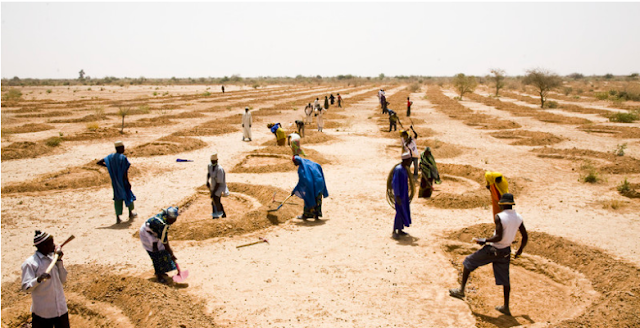Re-greening of the Sahel: Reviving techniques
Photo by: Anneli
Sundin CC BY-NC-ND
Physical Vs Economic water scarcity:
The 'water crisis' is often viewed to be a governance crisis. Economic water security is caused by lack of
investment in water infrastructure, or the lack of ability to afford the use of
an adequate water source. The demand from manufacturing and large-scale agriculture is due to increase
significantly. The extractive sector is a major consumer of water resources and
is almost entirely foreign and/or state-owned (Hendrix, 2014). Economic water
scarcity is prevalent in Sub-Saharan Africa, where structural issues
surrounding water governance and distribution can be observed.
The Sahel region, spanning across the Sahara and the Sudanian Savannah is a
semi-arid climate, primarily covered with grassland and savannah, with patches
of shrub-land (Lumumba, 2015). Reduced rainfall and rising air temperatures are
placing an increasing pressure on the land to produce abundant crops, it being historically a difficult area to
farm, with frequent droughts (Reij et. Al, 2009). Rain-fed agriculture is a
main source of income for many within the regions of Niger and Burkina
Faso, of which this post will focus on.
Re-greening of the Sahel:
The re-greening of
the Sahel began when local farmers’ practices were rediscovered and enhanced in
simple, low-cost ways by innovative farmers and nongovernmental organisations.
Re-greening is low-cost land restoration that allows
subsistence farmers to steer water security and, in turn food security into their own hands, without placing
reliance on government or privatised water distribution in regions of persistent droughts in regards to irrigation for farmlands. It began when local farmers practices were rediscovered and enhanced.
Ground water levels
in the Sahel plummeted, yields for staple crops Sorghum and millet declined.
Subsistence farming of millet and sorghum accounts for 40% of GDP and 87%
employment in Niger (Hendrix, 2014). A huge dependency on 2 crops, highlights
issues that can arise in the event of crop failure, in reference to drought,
this can create a significant drag on economic growth.
Sorghum
Proso millet (a
singular variation of millet)
Soil and water
conservation have been alive in the local pool of knowledge for centuries, the
sharing of farming techniques across regions is accelerating the revival of
natural vegetation (Lumumba, 2015). Farmers themselves play a key role in
disseminating knowledge through farmer-to-farmer visits, workshops, market days
and so called ‘zaï schools’ (sundin, 2013).
Techniques:
Indigenous
modification of traditional agroforestry, water and soil management practices
are used in both Niger and Burkina Faso. Most techniques are successfully able
to concentrate nutrients and water in small areas to improve soil fertility and
crop yield. 'ZAI' is a term that farmers in northern Burkina Faso use in
reference to small planting pits, these originate in western Sahel where
infertile, encrusted soil receive a variable, low rainfall.
Zai pit
Source: Brandon Lingbeek
Millet growing in Zai pits - Burkina Faso
Source: Hamado Sawadogo.
Another technique in
Burkina Faso's central Plateau is of farmers sewing crops in planting pits and
building stone contour bunds to capture rainwater runoff and soil. This uses
easily accessible and mostly free resources and has helped to rehabilitate 300,000
hectares of land and produce an additional 80,000 tonnes of food per year (Reij et. Al, 2009).
Concentrating
nutrients and water precisely where needed increases soil fertility. Manure is often added, termites
enhancing soil architecture and water infiltration and retention (Reij et. Al, 2009). The pits retain water for long periods of
time, allowing crops to survive dry spells.
Stone contour bunds:
Contour bunds for trees are a simplified form of micro-catchments. Common in Niger, the design allows rain run-off to spread evenly across an area, and slows down the flow enabling water to infiltrate the soil. The practice improves the soil by trapping sediments and organic matter within the plots instead of allowing them to wash away with the rain (Reij et. Al, 2009). Planting more trees to accompany these small plots reduce wind speed as well as evaporation, reducing the chance of crops being submerged by sand.
Bibliography:
Hendrix, C. 2014. 'Water and Security in Niger and the Sahel.' Research
Brief
Lumumba, J. 2015. 'Regreening the Sahel: Restoring native vegetation
using Assisted Natural Regeneration.' https://www.bothends.org/uploaded_files/inlineitem/CS7_Mali_RNC_Feb15.pdf
Reij, C. Smale, M.
Gray Tappan, G. 2009 'Re-greening the Sahel:
farmer-led innovation in Burkina Faso and Niger'. International Food
Policy Research Institute.
Sundin, A. 2013. 'Re-greening the Sahel?' https://www.siani.se/blog/re-greening-sahel-anneli-sundin/
http://www.fao.org/docrep/u3160e/u3160e07.htm#5.3%20contour%20bunds%20for%20trees
(contour bund picture)
Video produced by Shramajeevi Agri Films: https://www.youtube.com/watch?v=r4mIeOGmq0E







Hi!
ReplyDeleteThis is a very interesting approach, especially for low income and small-scale farmers. I like the idea how you can easily modify a landscape to use the water more efficiently!!
I was wondering what you mean when you were writing "The pits retain water for long periods of time, allowing crops to survive dry spells"? How long is a "long period"? Is there any study how long the pits can retain water? Thank you!
Cheers,
Fiona
Hi Fiona,
DeleteThank you for your question! Apologies for the slow reply.
The length of time water is retained would depend on the soil type and permeability. As the soil is likely to be harder and more tightly packed, creating the stone contour bunds will retain water for longer than soil that is more loose. However, as it is in a concentrated and contained area it will be able to slowly absorb into the soil.
I am yet to come across a paper with the exact period of time the water is retained for, if any reader knows of one please comment below, I'd be very interested to find out.
Joelle